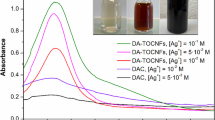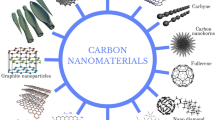Abstract
We develop an antimicrobial active robust metal-cellulose nanohybrid by covalent assembly of metal nanoparticles on cellulose fabric using a simple impregnation of thiol-modified cellulose fabric in colloidal silver (Ag) or palladium (Pd) nanoparticle solutions. The combined results of high resolution transmission electron microscopy (HR-TEM), field emission scanning electron microscopy (FE-SEM), energy-dispersive X-ray spectroscopy (EDXS) and inductively coupled plasma atomic emission spectrometry (ICP-AES) reveal that the nanoparticles are highly loaded and dispersed in the thiol-modified cellulose fabric, and X-ray photoelectron spectroscopy (XPS) analysis reveals that the nanoparticles are immobilized in the fabric by a strong and stable covalent bond with thiol functional group. This robust covalent linkage between the nanoparticles and the fabric leads to a remarkable suppression of the release of metal nanoparticles from the fabric. In addition, the metal-cellulose nanohybrids show high antimicrobial activity in excess of 99.9 % growth inhibition of the microorganism. Thus, we anticipate that our metal-cellulose nanohybrid may not only protect cell damage caused by penetration and fixation of metal nanoparticles into the human body but also act as a sustainable biomedical textile.








Similar content being viewed by others
References
Ahamed M, Karns M, Goodson M, Rowe J, Hussain SM, Schlager JJ, Hong Y (2008) DNA damage response to different surface chemistry of silver nanoparticles in mammalian cells. Toxicol Appl Pharmacol 233(3):404–410
AshaRani PV, Mun GLK, Hande MP, Valiyaveettil S (2009) Cytotoxicity and genotoxicity of silver nanoparticles in human cells. ACS Nano 3(2):279–290
Benn TM, Westerhoff P (2008) Nanoparticle silver released into water from commercially available sock fabrics. Environ Sci Technol 42(11):4133–4139
Caro C, López-Cartes C, Zaderenko P, Mejías JA (2008) Thiol-immobilized silver nanoparticle aggregate films for surface enhanced Raman scattering. J Raman Spectrosc 39(9):1162–1169
Chen K, Robinson HD (2011) Robust dithiocarbamate-anchored amine functionalization of Au nanoparticles. J Nanopart Res 13(2):751–761. doi:10.1021/ma00210a028
Dong H, Hinestroza JP (2009) Metal nanoparticles on natural cellulose fibers: electrostatic assembly and in situ synthesis. ACS Appl Mater Interfaces 1(4):797–803. doi:10.1021/am800225j
Gaarenstroom SW, Winograd N (1977) Initial and final state effects in the ESCA spectra of cadmium and silver oxides. J Chem Phys 67(8):3500–3506
Geranio L, Heuberger M, Nowack B (2009) The behavior of silver nano textiles during washing. Environ Sci Technol 43(21):8113–8118
Gorenšek M, Recelj P (2009) Reactive dyes and nano-silver on PA6 micro knitted goods. Text Res J 79(2):138–146
He J, Kunitake T, Nakao A (2003) Facile in situ synthesis of noble metal nanoparticles in porous cellulose fibers. Chem Mater 15(23):4401–4406. doi:10.1021/cm034720r
Ho TL (1975) The hard soft acids bases (HSAB) principle and organic chemistry. Chem Rev 75(1):1–20
Hu B, Zhao Y, Zhu HZ, Yu SH (2011) Selective chromogenic detection of thiol-containing biomolecules using carbonaceous nanospheres loaded with silver nanoparticles as carrier. ACS Nano 5(4):3166–3171
Kalita M, Basel MT, Janik K, Bossmann SH (2009) Optical and electronic properties of metal and semiconductor nanostructures. In: Nanoscale materials in chemistry. Wiley, London, pp 537–578. doi:10.1002/9780470523674.ch16
Králik M, Biffis A (2001) Catalysis by metal nanoparticles supported on functional organic polymers. J Mol Catal A Chem 177(1):113–138
Ladhe AR, Frailie P, Hua D, Darsillo M, Bhattacharyya D (2009) Thiol-functionalized silica-mixed matrix membranes for silver capture from aqueous solutions: experimental results and modeling. J Membr Sci 326(2):460–471
Larese FF, D’Agostin F, Crosera M, Adami G, Renzi N, Bovenzi M, Maina G (2009) Human skin penetration of silver nanoparticles through intact and damaged skin. Toxicology 255(1–2):33–37
Lee HJ, Yeo SY, Jeong SH (2003) Antibacterial effect of nanosized silver colloidal solution on textile fabrics. J Mater Sci 38(10):2199–2204
Lee HY, Park HK, Lee YM, Kim K, Park SB (2007) A practical procedure for producing silver nanocoated fabric and its antibacterial evaluation for biomedical applications. Chem Commun 28:2959–2961. doi:10.1039/b703034g
McKenna KP (2009) Unique bonding in nanoparticles and powders. In: Nanoscale materials in chemistry. Wiley, London, pp 15–36. doi:10.1002/9780470523674.ch2
Morones JR, Elechiguerra JL, Camacho A, Holt K, Kouri JB, Ramírez JT, Yacaman MJ (2005) The bactericidal effect of silver nanoparticles. Nanotechnology 16(10):2346–2353
Niskanen J, Shan J, Tenhu H, Jiang H, Kauppinen E, Barranco V, Picó F, Yliniemi K, Kontturi K (2010) Synthesis of copolymer-stabilized silver nanoparticles for coating materials. Colloid Polym Sci 288(5):543–553
Park SY, Ryu S-Y, Kwak S-Y (2011) Antibacterial metal-fiber hybrid with covalent assembly of silver and palladium nanoparticles on cellulose fibers. In: 2010 international conference on biology, environment and chemistry, Hong Kong, 12. 28–30. 2010. 2011. IPCBEE, pp 183–186
Pearson RG (1963) Hard and soft acids and bases. J Am Chem Soc 85(22):3533–3539
Pearson RG, Songstad J (1967) Application of the principle of hard and soft acids and bases to organic chemistry. J Am Chem Soc 89(8):1827–1836
Perelshtein I, Applerot G, Perkas N, Guibert G, Mikhailov S, Gedanken A (2008) Sonochemical coating of silver nanoparticles on textile fabrics (nylon, polyester and cotton) and their antibacterial activity. Nanotechnology 19(24):245705–245711
Piao YZ, Jang YJ, Shokouhimehr M, Lee IS, Hyeon T (2007) Facile aqueous-phase synthesis of uniform palladium nanoparticles of various shapes and sizes. Small 3(2):255–260. doi:10.1002/smll.200600402
Rance GA, Khlobystov AN (2010) Nanoparticle-nanotube electrostatic interactions in solution: the effect of pH and ionic strength. PCCP 12(36):10775–10780
Rodriguez JA, Hrbek J (1999) Interaction of sulfur with well-defined metal and oxide surfaces: unraveling the mysteries behind catalyst poisoning and desulfurization. Acc Chem Res 32(9):719–728
Romanska D, Mazur M (2003) Electrochemical preparation of thiol-coated silver nanostructures on highly oriented pyrolytic graphite. Langmuir 19(11):4532–4534
Savard D, Bedard LP, Barnes SJ (2006) TCF selenium preconcentration in geological materials for determination at sub-mu gg(-1) with INAA (Se/TCF-INAA). Talanta 70(3):566–571. doi:10.1016/j.talanta.2006.01.010
Schmid G, Simon U (2005) Gold nanoparticles: assembly and electrical properties in 1–3 dimensions. Chem Commun 6:697–710
Schnippering M, Carrara M, Foelske A, Kotz R, Fermin DJ (2007) Electronic properties of Ag nanoparticle arrays. A Kelvin probe and high resolution XPS study. PCCP 9:725–730. doi:10.1039/b611496b
Serp P, Corrias M, Kalck P (2003) Carbon nanotubes and nanofibers in catalysis. Appl Catal A Gen 253(2):337–358
Shateri Khalil-Abad M, Yazdanshenas ME, Nateghi MR (2009) Effect of cationization on adsorption of silver nanoparticles on cotton surfaces and its antibacterial activity. Cellulose 16(6):1147–1157
Shen JS, Xu B (2011) In situ encapsulating silver nanocrystals into hydrogels. A “green” signaling platform for thiol-containing amino acids or small peptides. Chem Commun 47(9):2577–2579
Shipway AN, Katz E, Willner I (2000) Nanoparticle arrays on surfaces for electronic, optical, and sensor applications. Chem Phys Chem 1(1):18–52
Smiechowicz E, Kulpinski P, Niekraszewicz B, Bacciarelli A (2011) Cellulose fibers modified with silver nanoparticles. Cellulose 18(4):975–985
Wolan JT, Hoflund GB (1998) Surface characterization study of AgF and AgF2 powders using XPS and ISS. Appl Surf Sci 125(3–4):251–258
Xu Y, Xie X, Guo J, Wang S, Wang Y, Mathur VK (2006) Effects of annealing treatment and pH on preparation of citrate-stabilized PtRu/C catalyst. J Power Sour 162(1):132–140
Yang Z, Liu ZW, Allaker RP, Reip P, Oxford J, Ahmad Z, Ren G (2010) A review of nanoparticle functionality and toxicity on the central nervous system. J R Soc Interface 7(SUPPL. 4):S411–S422. doi:10.1098/rsif.2010.0158.focus
Yokota S, Kitaoka T, Opietnik M, Rosenau T, Wariishi H (2008) Synthesis of gold nanoparticles for in situ conjugation with structural carbohydrates. Angew Chem Int Ed Engl 47(51):9866–9869
Zhang S, Li J, Lykotrafitis G, Bao G, Suresh S (2009) Size-dependent endocytosis of nanoparticles. Adv Mater 21(4):419–424
Acknowledgments
This research was supported by Basic Science Research Program through the National Research Foundation of Korea (NRF) funded by the Ministry of Education, Science and Technology (R11-2005-065).
Author information
Authors and Affiliations
Corresponding author
Electronic supplementary material
Below is the link to the electronic supplementary material.
Rights and permissions
About this article
Cite this article
Park, S.Y., Chung, J.W., Priestley, R.D. et al. Covalent assembly of metal nanoparticles on cellulose fabric and its antimicrobial activity. Cellulose 19, 2141–2151 (2012). https://doi.org/10.1007/s10570-012-9773-6
Received:
Accepted:
Published:
Issue Date:
DOI: https://doi.org/10.1007/s10570-012-9773-6




